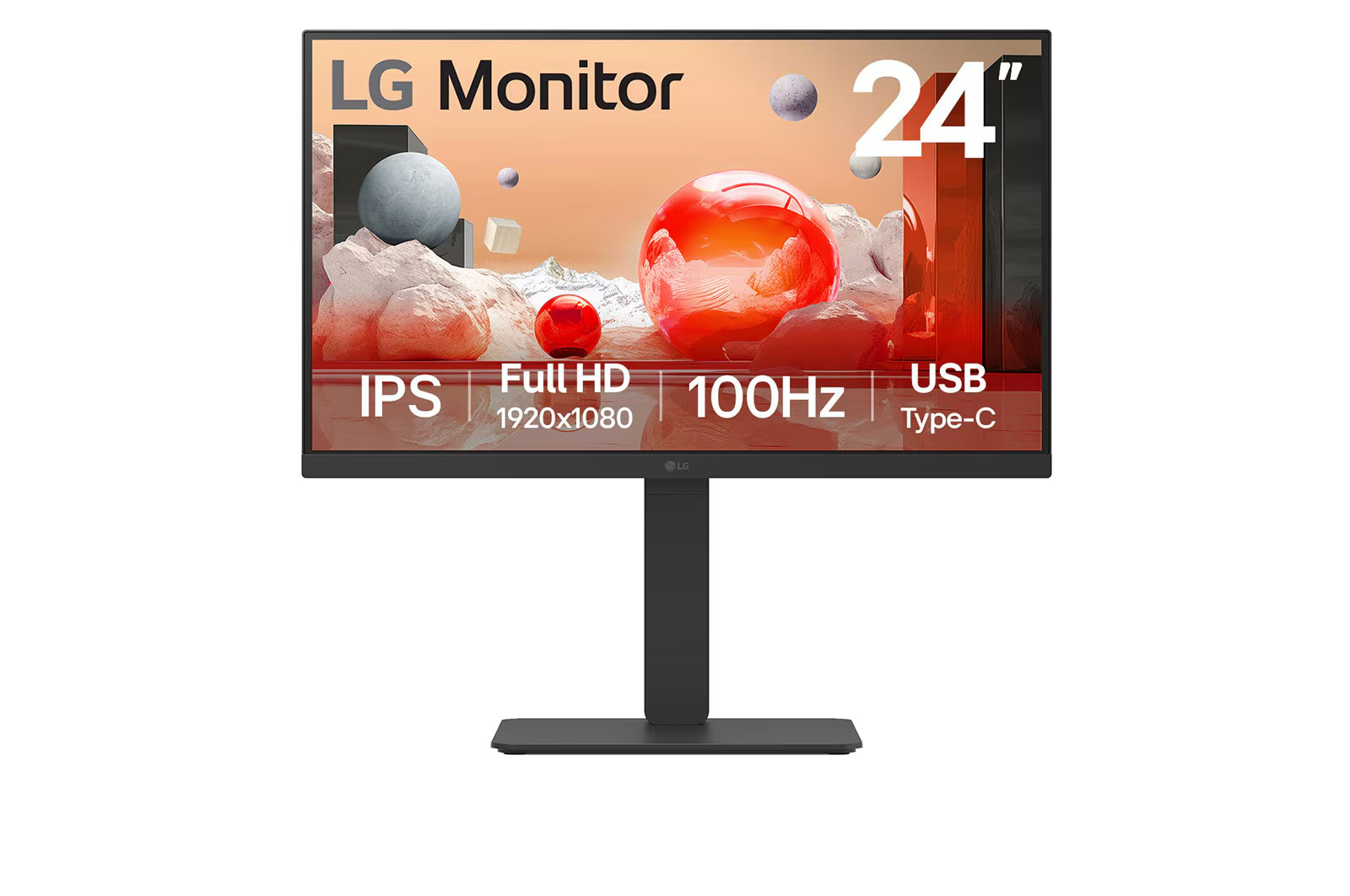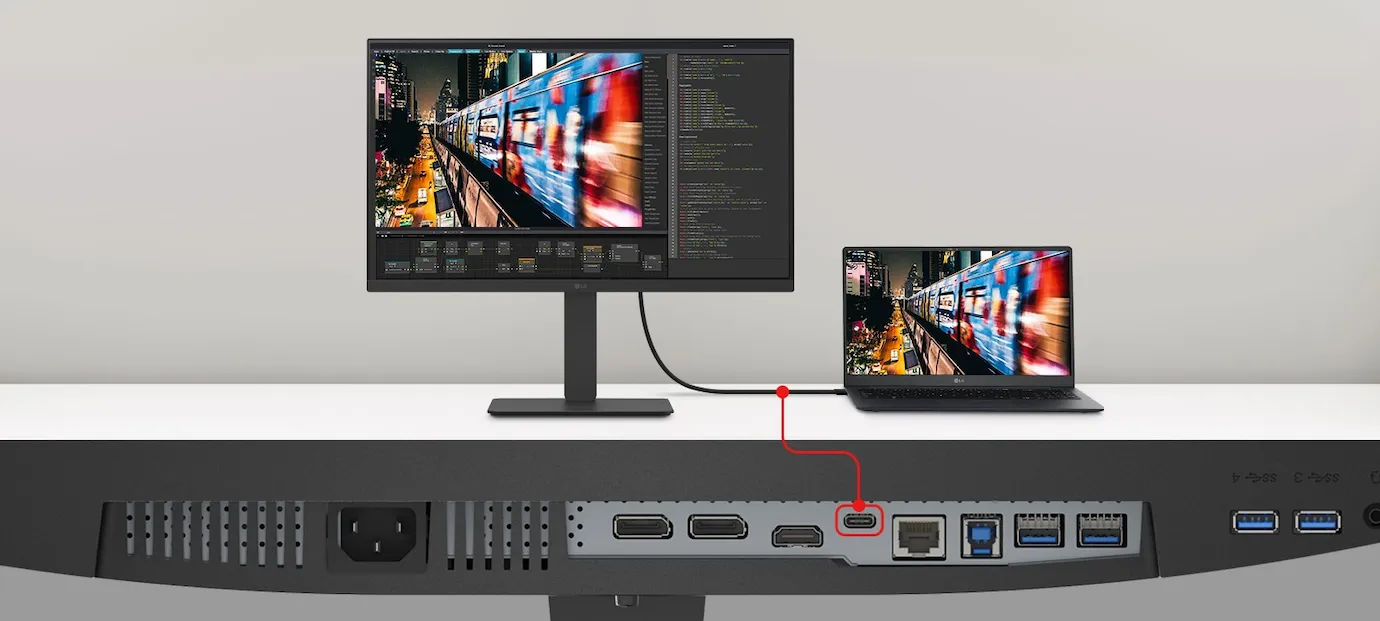







































£219.90*
- Resolution 1920 x 1080 Full HD
- Diagonal 24"
- Panel type IPS
- Refresh Rate 100Hz



Product information
The LG 24BA750 monitor offers a compact but powerful solution for modern workstations. With its 23.8-inch Full HD IPS display, integrated speakers and versatile connection options such as USB Type-C™ and RJ45, this monitor is ideal for an efficient and comfortable working environment.
The technical data at a glance:
- Screen size: 23.8" Full HD (1920x1080) IPS display
- Refresh rate: 100Hz
- Ports: USB Type-C™ (PD 65W), RJ45 and other interfaces
- Ergonomics: Tilt, swivel, pivot and height-adjustable stand (bi-directional)
- Comfort features: Reader Mode & Flicker Safe
- Integrated speakers and power supply
Clear and precise display with IPS technology
The 23.8-inch Full HD IPS display of the LG 24BA750 impresses with clear and consistent colour representations, even at wide viewing angles. Thanks to IPS technology, the monitor is ideal for tasks where colour accuracy is crucial. This guarantees excellent image quality, no matter what angle you look at the monitor from.

Maximised productivity thanks to 100Hz and USB Type-C™
With a refresh rate of 100Hz, the monitor ensures smooth transitions without delays or motion blur. This not only improves the user experience, but also increases efficiency when working on complex tasks. The USB Type-C™ interface offers an all-in-one solution for transferring data, controlling the display and simultaneously charging devices with up to 65W - all via a single cable.

Integrated speakers and versatile connectivity
Theintegrated speakers of the LG 24BA750 eliminate the need for additional external devices, ideal for web conferencing or video playback. With numerous connection options, including RJ45 and USB Type-C™, the monitor offers maximum flexibility and adapts to any working environment. Your workspace will always be neat and tidy as fewer cables are required.
Ergonomic design for maximum comfort
With the height-adjustable, swivelling, tilting and rotating stand, the LG 24BA750 adapts to any working position and ensures ergonomic use. The ability to tilt or swivel the monitor in different directions is particularly practical, making it much easier to collaborate with colleagues or customers. This allows you to adapt the monitor perfectly to your needs and ensure comfort even during long working hours.
Eye-friendly technologies for relaxed working
The Reader Mode and Flicker Safe technology of the LG 24BA750 help to protect your eyes. Reader Mode adjusts the colour temperature and brightness to make reading documents more comfortable, while Flicker Safe reduces invisible flickering, minimising eye strain. These features make the monitor ideal for continuous use and help to maintain concentration and well-being while working.
The LG 24BA750 offers an excellent blend of advanced technology, ergonomic design and versatile connectivity, making it the perfect choice for the modern workplace.
Technical data
| Name | LG 24BA750-B 24" Monitor |
|---|---|
| Article number | 1000033164 |
| GTIN/EAN | 8806096207079 |
| Manufacturer SKU | 24BA750-B.AEU |
| EPREL ID | 2024318 |
| Model name | 24BA750-B |
| Brand | LG |
| Product Type | Monitor |
| Panel type | IPS |
| Resolution | 1920 x 1080 Full HD |
| Diagonal | 24" |
| Aspect Ratio | 16:9 |
| Viewing angle - Horizontal | 178° |
| Viewing angle - Vertical | 178° |
| Contrast Ratio | 1,300 :1 |
| Max. Brightness | 250 cd/m² |
| Response time | 5ms |
| Refresh Rate | 100Hz |
| Support - VESA | 100 x 100 |
| Inputs | 1x Displayport , 1x Ethernet , 1x HDMI , 1x USB-C , 4x USB-A |
| Outputs | 1x 3,5mm Jack , 1x Displayport |
| Product width | 53.96 cm |
| Product height | 32.3 cm |
| Product depth | 5 cm |
| Weight | 6.6 kg |
| Colour | Black |
| EEK Spectrum | A to G |
| Energy efficency class | D |
| Condition | New |
| Warranty | 36 Month |
| Warranty type | Swap service Service and support information |
Product safety
| Person responsible for the EU |
|---|
| LG Electronics Deutschland GmbH |
| Alfred-Herrhausen-Allee 3-5 |
| 65760 Eschborn |
| Germany |
| info@lge.de |



